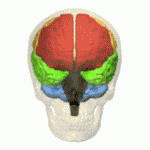
Photo from wikipedia
Introduction: Working memory (WM) refers to the temporary storage and manipulation of information. Short-term memory storage can be divided into separate subsystems for verbal information and visual information. We explored… Click to show full abstract
Introduction: Working memory (WM) refers to the temporary storage and manipulation of information. Short-term memory storage can be divided into separate subsystems for verbal information and visual information. We explored the capacity of visual WM in patients with temporal lobe glioma. Methods: In this study, we assessed 30 patients with temporal lobe glioma and 30 healthy controls (HCs) using a method that combined memory tests with visual WM tasks (digital span task, spatial capacity N-back task, and emotional N-back task). Results: The results revealed that groups did not differ in terms of demographics, estimated intelligence, and level of psyc distress. For visual WM tasks, statistically significant differences were not found on the 1-back tasks and forward versions of simple span tasks between the temporal patient (TP) group and the HC group. Analysis of correct responses of the experimental tasks suggested that the TP group was significantly different from the HC group in the 2-back tasks and backward versions of simple span tasks. For reaction times, spatial capacity 2-back task and emotional 2-back task showed the TP group was significantly different from the HC group. Conclusion: These findings revealed that visual WM scores of temporal glioma patients were lower than HCs, and hence, the temporal lobe may be a certain neuroanatomical structure in the WM network.
Journal Title: European Neurology
Year Published: 2022
Link to full text (if available)
Share on Social Media: Sign Up to like & get
recommendations!